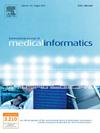Unified modeling language for patient-centered telerehabilitation: A comprehensive framework integrating medical and biopsychosocial pathways
IF 3.7
2区 医学
Q2 COMPUTER SCIENCE, INFORMATION SYSTEMS
International Journal of Medical Informatics
Pub Date : 2025-03-21
DOI:10.1016/j.ijmedinf.2025.105882
引用次数: 0
Abstract
Background: Effective telerehabilitation requires robust, standardized models to ensure comprehensive and continuous patient monitoring. However, existing rehabilitation models often lack integration, failing to cover the entire care continuum and its interdisciplinary aspects. This gap limits their applicability in real-world settings.
Objective: This study introduces a semi-formal, Unified Modeling Language (UML)-based framework that provides a holistic, patient-centered representation of the rehabilitation pathway. The model is designed to bridge gaps in care coordination, aligning with recent scientific advances and healthcare policies emphasizing patient empowerment and interdisciplinary collaboration.
Methods: Using a professional didactics approach, we conducted a literature review, field observations, and expert consultations (questionnaires, interviews) to map rehabilitation pathways across diverse conditions and settings. The model was iteratively refined based on expert feedback to ensure its accuracy and usability.
Results: Our findings reveal significant fragmentation in rehabilitation pathways, driven by diverse clinical practices and discontinuities in care. To address this, the proposed UML-based model integrates medical, functional, psychosocial, and organizational data, ensuring a cohesive, capability-driven approach. The structured design enhances communication between stakeholders and improves interoperability across healthcare systems.
Conclusion: The proposed model provides a scalable foundation for digital telerehabilitation solutions, adaptable to various healthcare environments. By facilitating data integration and standardization, it supports better patient monitoring, decision-making, and personalized rehabilitation strategies. Future research will focus on refining the model to incorporate specialized rehabilitation fields and enhance interoperability with existing medical information systems.
以患者为中心的远程康复的统一建模语言:整合医学和生物心理社会途径的综合框架
背景:有效的远程康复需要稳健、标准化的模型,以确保全面和持续的患者监测。然而,现有的康复模式往往缺乏整合,未能涵盖整个护理连续体及其跨学科方面。这种差距限制了它们在现实环境中的适用性。目的:本研究引入了一种半形式化的、基于统一建模语言(UML)的框架,该框架提供了一个整体的、以患者为中心的康复路径表示。该模型旨在弥合护理协调方面的差距,与强调患者赋权和跨学科合作的最新科学进展和医疗保健政策保持一致。方法:采用专业教学方法,我们进行了文献综述、实地观察和专家咨询(问卷调查、访谈),以绘制不同条件和环境下的康复路径。在专家反馈的基础上对模型进行迭代改进,保证了模型的准确性和可用性。结果:我们的研究结果揭示了由不同的临床实践和护理的不连续性驱动的康复途径的显著碎片化。为了解决这个问题,建议的基于uml的模型集成了医学、功能、社会心理和组织数据,确保了一个有凝聚力的、能力驱动的方法。结构化设计增强了利益相关者之间的通信,并提高了医疗保健系统之间的互操作性。结论:提出的模型为数字远程康复解决方案提供了可扩展的基础,适用于各种医疗环境。通过促进数据集成和标准化,它支持更好的患者监测、决策和个性化康复策略。未来的研究将集中于改进模型,以纳入专业康复领域,并增强与现有医疗信息系统的互操作性。
本文章由计算机程序翻译,如有差异,请以英文原文为准。
求助全文
约1分钟内获得全文
求助全文
来源期刊

International Journal of Medical Informatics
医学-计算机:信息系统
CiteScore
8.90
自引率
4.10%
发文量
217
审稿时长
42 days
期刊介绍:
International Journal of Medical Informatics provides an international medium for dissemination of original results and interpretative reviews concerning the field of medical informatics. The Journal emphasizes the evaluation of systems in healthcare settings.
The scope of journal covers:
Information systems, including national or international registration systems, hospital information systems, departmental and/or physician''s office systems, document handling systems, electronic medical record systems, standardization, systems integration etc.;
Computer-aided medical decision support systems using heuristic, algorithmic and/or statistical methods as exemplified in decision theory, protocol development, artificial intelligence, etc.
Educational computer based programs pertaining to medical informatics or medicine in general;
Organizational, economic, social, clinical impact, ethical and cost-benefit aspects of IT applications in health care.
 求助内容:
求助内容: 应助结果提醒方式:
应助结果提醒方式:


